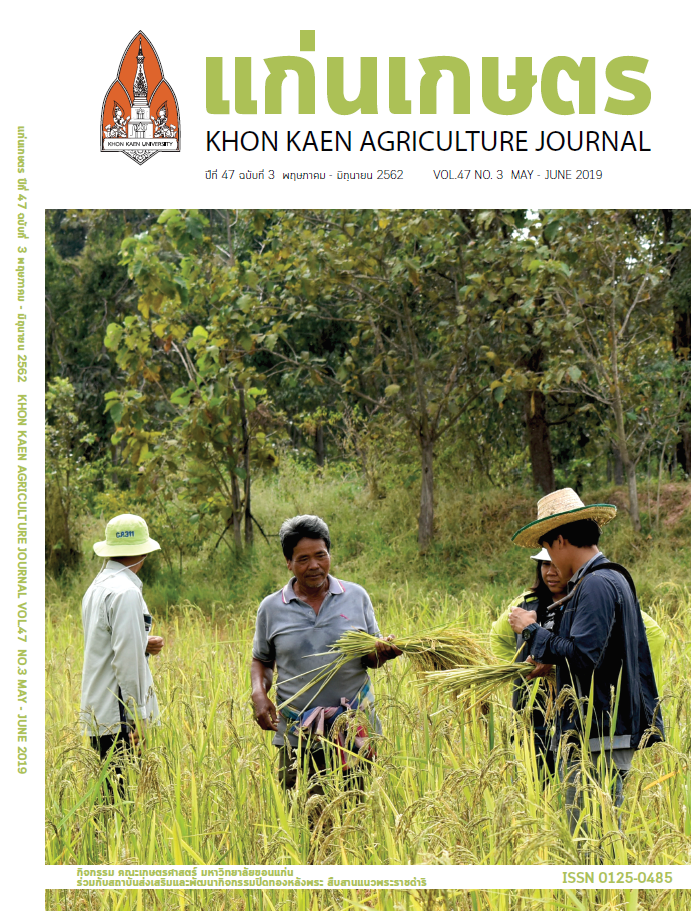การศึกษาประสิทธิภาพการป้องกันโรคบิดที่เกิดจาก Eimeria tenella ของน้ำมันหอมระเหยอบเชยจีน
Main Article Content
บทคัดย่อ
การศึกษาประสิทธิภาพการยับยั้งเชื้อบิดชนิด Eimeria tenella ของน้ำมันอบเชยจีนแบ่งเป็น 2 การทดลอง โดยการทดลองที่ 1ศึกษาการยับยั้งเชื้อบิดในระดับห้องปฏิบัติการ โดยให้เซลล์เพาะเลี้ยงชนิด MDBK สัมผัสกับสปอโรซอยท์จากเชื้อบิดและน้ำมันหอมระเหยอบเชยจีนที่ความเข้มข้นต่างกัน แล้วตรวจนับเซลล์ที่ถูกบุกรุกด้วยสปอโรซอยท์ ผลพบความสัมพันธ์เป็นแบบลอกการิทึมด้วยสมการ y = -9.2791ln(x)-31.5858 โดยมีค่า IC50 และ IC100 เท่ากับ 0.00016 และ 0.03 มคล./มล.ตามลำดับ จากนั้นนทำการทดสอบในตัวสัตว์โดยใช้น้ำมันอบเชยจีน 3 ระดับ (0.03, 0.20 และ 1.40 มคล./มล.) พบว่าที่ความเข้มข้น 0.20 มคล./มล.สามารถยับยั้งเชื้อบิดได้โดยไม่กระทบต่อการกินอาหารและน้ำของไก่เนื้อ การทดลองที่ 2 ศึกษาประสิทธิภาพการป้องกันโรคบิดของผลิตภัณฑ์น้ำมันอบเชยจีนในไก่เนื้อที่เลี้ยงในสภาพปกติ ใช้ไก่เนื้ออายุ 1 วัน จำนวน 768 ตัว แบ่งเป็น 4 กลุ่มๆ ละ 4 ซ้ำๆละ 48 ตัว สุ่มไก่ให้ได้รับกลุ่มทดลองดังนี้ กลุ่ม 1 ไม่กรอกเชื้อและไม่เสริมสารใดๆ กลุ่ม 2-4 ได้รับโอโอซีสต์จาก E. tenella จำนวน 2500 โอโอซีสต์ที่อายุ 14 วันและเสริมสารซาลิโนมัยซิน 0, 50 มก/กก.อาหารและผลิตภัณฑ์น้ำมันอบเชยจีน 0.20 มคล./มล.ในน้ำดื่ม ตามลำดับ สุ่มไก่4 ตัวต่อซ้ำที่อายุ 21 และ 35 วันเพื่อให้คะแนนรอยโรคบิดไส้ตันด้วยวิธีจุลพยาธิวิทยา พบว่าผลิตภัณฑ์น้ำมันอบเชยจีนแสดงประสิทธิภาพการป้องกันโรคบิดที่เกิดจาก E. tenella ด้อยกว่าผลในระดับห้องปฏิบัติการ ทั้งนี้อาจเกิดจากผลข้างเคียงของสารที่ใช้ในการเตรียมผลิตภัณฑ์
Article Details
เอกสารอ้างอิง
ณัฐวุฒิ เจริญไทย และ มัลลิกา ชมนาวัง. 2559. การพัฒนาน้ำมันอบเชยจีนชนิดระบบนำส่งยาแบบก่อให้เกิดไมโครอิมัลชันเองเพื่อใช้ในการต้านจุลชีพในไก่เนื้อ. รายงานวิจัยฉบับสมบูรณ์. สำนักงานกองทุนสนับสนุนการวิจัย, กรุงเทพฯ.
วรรณวิภา วรรณศิริ,นันทวัน บุณยะประภัศร,ทวีศักดิ์ ส่งเสริม และ นวลจันทร์ พารักษา. 2558. การใช้ผลิตภัณฑ์น้ำมันหอมระเหยชนิดละลายน้ำเพื่อการป้องกันโรคบิดในไก่เนื้อ. แก่นเกษตร. 43: 729-738.
สุรพันธ์ จิตวิริยนนท์. 2559. การทดสอบประสิทธิภาพ ของสารสกัดสมุนไพรในการป้องกันโรคบิดในไก่เนื้อ. วิทยานิพนธ์ปริญญาปรัชญาดุษฎีบัณฑิต มหาวิทยาลัยเกษตรศาสตร์, กรุงเทพฯ.
อรัญญา มโนสร้อย และจีรเดช มโนสร้อย. 2548. น้ำมันน้ำมันหอมระเหยและสารสกัดจากสมุนไพร. โรงพิมพ์ครองช่าง. เชียงใหม่.
อาริษา แสงศรี, เสาวลักษณ์ จงประกิจพงส์ และอำไพ นุสสติ. 2557. การเตรียมชิ้นเนื้อเยื่อด้วยน้ำยาเคมีเพื่อการตรวจทางพยาธิวิทยาโดยปราศจากไซลีน. สถาบันพยาธิวิทยา, กรมการแพทย์, กระทรวงสาธารณสุข.
Chapman, H.D. 2014. Milestones in avian coccidiosis research: a review. Poult. Sci. 93: 501-511.
Conway, D.P. and M.E. McKenzie. 2007. Poultry Coccidiosis Diagnostic and Testing Procedures. 3rd ed. Blackwell Publishing Asia, Australia.
Gerhold, R. W. 2016. Overview of coccidiosis in poultry. Veterinary Manual. Available Source: www.msdvetmanual.com/poultry/Coccidiosis/overview-ofcoccidiosis-in-poultry, March 6, 2018.
Hamid, K. A., H. Katsumi, T. Sakane, and A. Yamamoto. 2009. The effects of common solubilizing agents on the intestinal membrane barrier functions and membrane toxicity in rats. Int. J. Pharm. 379: 100-108.
Huczynski, A. 2012. Salinomycin: a new cancer drug candidate. Chem. Biol. Drug Des. 79: 235-238.
Jitviriyanon, S., P. Phanthong, P. Lomarat, N. Bunyapraphatsara, S. Porntrakulpipat, and N. Paraksa. 2016. In vitro study of anti-coccidial activity of essential oils from indigenous plants against Eimeria tenella. Vet. Parasitol. 228: 96-102.
Krishan, G and A. Narang. 2014. Use of essential oils in poultry nutrition: a new approach. J. Adv. Vet. Anim. Res.1: 156-162.
Laurent, F., R. Mancassola, S. Lacroix, R. Menezes, and M. Naciri. 2001. Analysis of chicken mucosal immune response to Eimeria tenella and Eimeria maxima infection by quantitative reverse transcription-PCR. Infect. Immun. 69: 2527-2534.
Lee, S. H., H. S. Lillehoj, S. I. Jang, K. W. Lee, M. S. Park, D. Bravo, and E. P. Lillehoj. 2011. Cinnamaldehyde enhances in vitro parameters of immunity and reduces in vivo infection against avian Coccidiosis. Br. J. Nutr. 106: 862-869.
Lorian, V. 1988. Differences between in vitro and in vivo studies. Antimicrob Agents Chemother. 32: 1600-1601.
Markiewicz, W., D. Barski, A. Burmanczuk, and E. Tomaszewska. 2014. Toxicity of salinomycin and narasin in turkeys. J. Elem. 19: 903-914.
National Research Council (NRC). 1994. Nutrient Requirements of Poultry. 9th ed. National Academy Press,
Washington, DC.Oussalah, M., S. Caillet, and M. Lacroix. 2006. Mechanism of action of Spanish Oregano, Chinese cinnamon, and Savory essential oils against cell membranes and walls of Escherichia coli O157:H7 and Listeria monocytogens. J. Food Prot. 69: 1046-1055.
Pangeni, R., S. W. Kang, M. Oak, E. U. Park, and J. W. Park. 2017. Oral delivery of quercetin in oil-in-water nanoemulsion: In vitro characterization and in vivo antiobesity efficacy in mice. J. Funct. Foods. 38: 571-581.
Prabuseenivasan, S., M. Jayakumar, and S. Ignacimuthu. 2006. In vitro antibacterial activity of some plant essential oils. BMC Complement Altern. Med. 6: 39-46.
Quiroz-Castañeda. 2018. Avian Coccidiosis, new Strategies of treatment. In farm animals diseases, Available: http:/www.intechopen.com/books/farm-animalsdiseases-recent-omic-trends-and-newstrategies-of-treatment. Accessed January 4, 2019.
Remmal, A., S. Achahbar, L. Bouddine, N. Chami, and F. Chami. 2011. In vitro destruction of Eimeria oocysts by essential oils. Vet. Parasitol. 182: 121-126.
Remmal, A., S. Achahbar, L. Bouddine, F. Chami, and N. Chami. 2013. Oocysticidal effect of essential oil components against chicken Eimeria oocysts. Int. J. Vet. Med. Res. Rep. 2013: 1-8.
Schmatz, D. M., M. S. Crane, and P. K., Murray. 1984. Purification of Eimeria sporozoites by DE-52 anion exchange chromatography. J. Protozool. 31: 181-183.
Shirley, M.W., A.L. Smith, and F.M. Tomley. 2005. The biology of avian Eimeria with an emphasis on their control by vaccination. Adv. Parasit. 60: 285-330.
Wu, L., Y. Qiao, L. Wang, J. Guo, G. Wang, W. He, L. Yin, and J. Zhao. 2015. A self-microemulsifying drug delivery system (SMEDDS) for a novel medicative compound against depression: a preparation and bioavailability study in rats. AAPS Pharm. Sci. Tech.16: 1051-1058.


